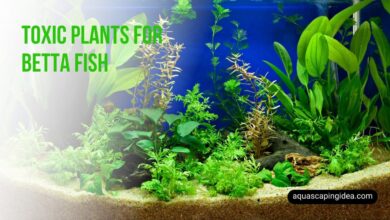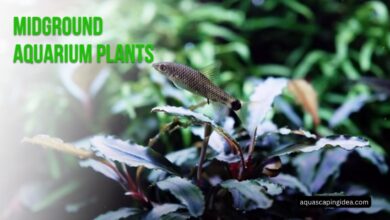How to Plant Anubias in Gravel?
Anubias is a popular aquatic plant genus known for its hardy nature, attractive appearance, and low maintenance requirements. These versatile plants are a favorite among both novice and experienced aquarists, thanks to their ability to thrive in various aquarium conditions. One of the most common methods of incorporating Anubias into your aquascape is by planting it in gravel. This comprehensive guide will walk you through the process of planting Anubias in gravel, providing you with the knowledge and techniques to ensure your plants flourish in their new underwater home.
Understanding Anubias
Before diving into the planting process, it’s essential to understand the unique characteristics of Anubias plants and why they are well-suited for gravel planting.
Characteristics of Anubias
Anubias plants are native to tropical and subtropical regions of Africa and belong to the Araceae family. They are known for their:
- Slow growth rate: Anubias grows slowly compared to many other aquarium plants, making it ideal for low-maintenance setups.
- Thick, leathery leaves: The leaves are sturdy and resistant to damage from fish or water currents.
- Rhizome-based growth: Anubias grows from a horizontal stem called a rhizome, which plays a crucial role in its planting method.
- Low light requirements: These plants can thrive in low to moderate light conditions, making them suitable for a wide range of aquarium setups.
- Adaptability: Anubias can grow both fully and partially submerged, offering versatility in aquascaping.
Popular Anubias Species for Aquariums
While there are over 13 known species of Anubias, some are more commonly found in the aquarium trade. Here are a few popular options:
- Anubias barteri: This is the most common species, with several varieties like ‘Nana’, ‘Petite’, and ‘Coffeefolia’.
- Anubias nana: A compact species perfect for smaller aquariums or foreground planting.
- Anubias hastifolia: Known for its larger, arrow-shaped leaves.
- Anubias congensis: Features elongated leaves and can grow quite tall.
- Anubias afzelii: Recognizable by its distinctive ribbed leaves.
Preparing for Planting
Before you start planting your Anubias in gravel, it’s crucial to gather the necessary materials and prepare your aquarium environment. This preparation will help ensure a smooth planting process and increase the chances of your Anubias thriving in its new home.
Materials Needed
To plant Anubias in gravel, you’ll need the following items:
- Anubias plants: Choose healthy specimens with vibrant leaves and intact rhizomes.
- Aquarium gravel: Opt for a substrate with a grain size between 2-5 mm for optimal results.
- Aquascaping tweezers: Long tweezers will help you place the plants precisely without disturbing the substrate.
- Scissors: Clean, sharp scissors for trimming roots or leaves if necessary.
- Water conditioner: To treat tap water and make it safe for your plants and fish.
- Liquid fertilizer: While not essential, it can promote healthier growth.
- Bucket: For preparing and holding water during the planting process.
- Gloves: To keep your hands clean and protect any cuts from aquarium water.
Preparing Your Aquarium
Follow these steps to prepare your aquarium for Anubias planting:
- Clean the tank: If you’re working with an existing setup, perform a partial water change and clean the gravel to remove debris.
- Check water parameters: Ensure your water conditions are suitable for Anubias. Ideal parameters are:
- Temperature: 72-82°F (22-28°C)
- pH: 6.0-7.5
- Water hardness: 3-8 dKH
- Prepare the gravel: If using new gravel, rinse it thoroughly to remove dust and debris. For an existing tank, gently stir the gravel to release trapped waste, then siphon it out.
- Plan your layout: Decide where you want to place your Anubias plants. Consider factors like lighting, water flow, and the overall aesthetic of your aquascape.
- Adjust lighting: Ensure your aquarium lighting is appropriate for Anubias. While they can tolerate low light, moderate lighting (10-20 lumens per liter) will promote healthier growth.
Preparing the Anubias Plants
Before planting, take these steps to prepare your Anubias:
- Inspect the plants: Check for any signs of disease, pests, or damage. Healthy Anubias should have firm, green leaves and a solid rhizome.
- Quarantine (optional): If introducing new plants to an established tank, consider quarantining them for 2-3 weeks to prevent the introduction of pests or diseases.
- Trim if necessary: Remove any yellow or damaged leaves. If the roots are excessively long, you can trim them to about 1-2 inches.
- Separate rhizomes (if applicable): If you have a large Anubias plant, you can divide the rhizome into smaller sections, ensuring each piece has at least 3-4 leaves.
Step-by-Step Guide to Planting Anubias in Gravel
Now that you’ve prepared your aquarium and plants, it’s time to start the planting process. Follow these steps carefully to ensure your Anubias is properly planted and set up for success.
Step 1: Create a Depression in the Gravel
Using your fingers or aquascaping tweezers, create a small depression in the gravel where you want to plant your Anubias. The depression should be deep enough to accommodate the roots but shallow enough to keep the rhizome above the substrate.
Step 2: Position the Anubias
Gently place the Anubias into the depression you’ve created. The most critical aspect of this step is ensuring that the rhizome remains above the gravel. The rhizome is the thick, horizontal stem from which the leaves and roots grow. Burying the rhizome can lead to rot and eventually kill the plant.
Step 3: Anchor the Roots
Carefully cover the roots with gravel, leaving the rhizome exposed. Use your tweezers to gently push gravel around the roots, providing stability to the plant. Be careful not to damage the delicate roots during this process.
Step 4: Secure the Plant
For additional stability, especially in tanks with strong water currents, you can use plant weights or thin, inert fishing line to secure the Anubias to a small, flat stone placed on top of the gravel. This temporary measure will help the plant establish itself.
Step 5: Adjust and Fine-tune
Once the plant is in place, make any necessary adjustments to its position. Ensure that the leaves are oriented in a way that looks natural and allows for proper water flow around the plant.
Step 6: Repeat for Additional Plants
If you’re planting multiple Anubias, repeat the process for each plant. Remember to space them appropriately, considering their potential growth and the overall aesthetic of your aquascape.
Step 7: Perform a Water Change
After planting, perform a partial water change (about 25-30% of the tank volume) to remove any debris stirred up during the planting process. Use a water conditioner to treat the new water before adding it to the tank.
Care and Maintenance After Planting
Once your Anubias is planted, proper care and maintenance will ensure its long-term health and growth. Here are some essential tips to keep your Anubias thriving:
Lighting
While Anubias can tolerate low light conditions, moderate lighting will promote healthier growth and more vibrant leaves. Aim for 10-20 lumens per liter, or 8-10 hours of light per day. Avoid intense direct light, which can lead to algae growth on the slow-growing Anubias leaves.
Fertilization
Anubias are not heavy feeders, but they can benefit from regular, light fertilization. Use a liquid fertilizer formulated for aquarium plants, following the manufacturer’s instructions for dosage. typically, fertilizing once a week or every other week is sufficient.
Water Parameters
Maintain stable water parameters to support your Anubias:
- Temperature: 72-82°F (22-28°C)
- pH: 6.0-7.5
- Water hardness: 3-8 dKH
Regular water testing and partial water changes (10-20% weekly) will help maintain these parameters.
Pruning and Maintenance
Anubias are slow-growing plants that require minimal pruning. However, you should:
- Remove any yellow or damaged leaves to maintain plant health and appearance.
- Trim roots if they become excessively long and start to float.
- Control algae growth by gently wiping leaves with a soft cloth or sponge during water changes.
Propagation
As your Anubias grows, you can propagate it to create new plants:
- Identify a healthy section of the rhizome with at least 3-4 leaves.
- Using clean, sharp scissors, cut the rhizome, ensuring each section has some roots.
- Plant the new sections following the same method described earlier.
Common Issues and Troubleshooting
Even with proper care, you may encounter some issues with your Anubias. Here are some common problems and their solutions:
Yellowing Leaves
Cause: Nutrient deficiency, old age, or insufficient light. Solution: Check your fertilization routine, ensure proper lighting, and remove old leaves to encourage new growth.
Rhizome Rot
Cause: Rhizome buried in substrate or poor water quality. Solution: Ensure the rhizome is above the gravel and improve water quality through regular maintenance.
Slow Growth
Cause: Natural characteristic of Anubias, but can be exacerbated by poor conditions. Solution: Be patient, ensure proper nutrition, lighting, and water parameters. Growth of 1-3 new leaves per month is normal.
Algae Growth on Leaves
Cause: Excessive light or nutrients in the water. Solution: Reduce lighting duration or intensity, balance fertilization, and manually remove algae during water changes.
Floating Plants
Cause: Insufficient anchoring or fish disturbance. Solution: Reposition the plant, ensuring roots are well-covered with gravel, or temporarily anchor with weights or fishing line.
FAQ: Planting Anubias in Gravel
Here are answers to some frequently asked questions about planting Anubias in gravel:
- Q: Can I plant Anubias completely buried in gravel? A: No, the rhizome should always be above the gravel to prevent rot. Only the roots should be buried.
- Q: How often should I fertilize my Anubias? A: Light fertilization once a week or every other week is usually sufficient. Follow the instructions on your chosen aquarium plant fertilizer.
- Q: Can Anubias grow in a non-CO2 supplemented tank? A: Yes, Anubias can thrive without additional CO2. They are slow-growing and adapt well to various conditions.
- Q: How do I know if my Anubias is getting enough light? A: Healthy Anubias will have vibrant green leaves and steady, albeit slow, growth. If leaves become pale or growth stalls, you may need to adjust lighting.
- Q: Can I keep Anubias with fish that like to dig in the substrate? A: Yes, but you may need to secure the plants more firmly or attach them to hardscape elements to prevent uprooting.
- Q: How long does it take for Anubias to establish in gravel? A: Anubias typically takes 3-4 weeks to establish its root system in the new substrate. You may notice new leaf growth after 4-6 weeks.
- Q: Can I trim the leaves of my Anubias? A: Yes, you can trim old or damaged leaves at the base where they meet the rhizome. This can encourage new growth.
- Q: Is it normal for Anubias to grow aerial roots? A: Yes, Anubias often develops aerial roots from the rhizome. These are normal and can be left alone or gently guided into the substrate.
- Q: Can Anubias survive in brackish water? A: Some Anubias species can tolerate slightly brackish conditions, but they generally prefer freshwater environments.
- Q: How do I prevent snails from eating my Anubias? A: While Anubias are not a preferred food for most snails, you can dip new plants in a mild bleach solution before planting to remove snail eggs. Additionally, maintaining good water quality and removing excess food can help control snail populations.
Conclusion
Planting Anubias in gravel is a rewarding process that can significantly enhance the beauty and health of your aquarium. By following the steps outlined in this guide and maintaining proper care, you can ensure your Anubias thrives in its new environment. Remember that patience is key when working with these slow-growing plants – the results of your efforts will become more apparent over time as your Anubias establishes itself and begins to grow.
Anubias plants offer a unique combination of aesthetic appeal and low-maintenance care, making them an excellent choice for aquarists of all experience levels. Whether you’re creating a lush underwater forest or adding a touch of green to a minimalist aquascape, Anubias planted in gravel can serve as a cornerstone of your aquatic design.
As you continue to care for your Anubias, don’t be afraid to experiment with different placements and combinations with other plants and hardscape elements. The versatility of Anubias allows for endless creative possibilities in your aquarium design. With proper care and attention, your Anubias will provide years of natural beauty and contribute to a healthy, thriving aquatic ecosystem.


